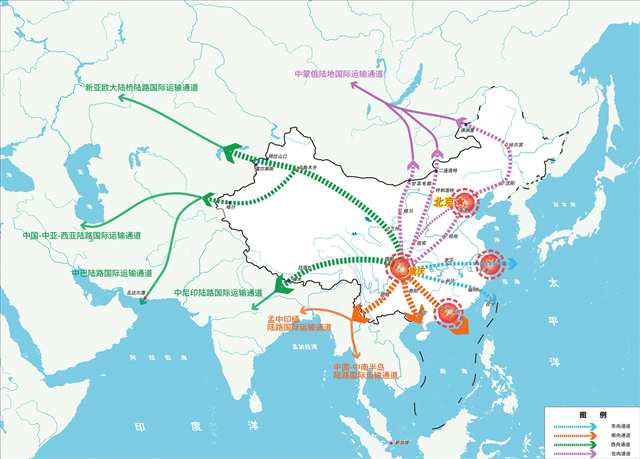Chongqing to build 10 foreign comprehensive transport routes
2024-03-29 16:07:43 听新闻

CHONGQING (CQNEWS) -- Territorial Spatial Planning of Chongqing Municipality (2021-2035) (hereinafter referred to as the Planning) proposes to 10 international comprehensive transport routes (hereinafter referred to as the "routes") to connect major national urban clusters and six major national economic corridors.
What are the layout of the 10 routes, and what’s the purpose of them? On March 27, the reporter interviewed Jin Wei, Secretary of the Party Committee and President of Chongqing Transport Planning and Research Institute.
Interpretation
Routes are planned to promote the implementation of national strategies
"The ten routes are planned to promote the implementation national strategies such as the construction of the new western land-sea corridor, high-quality development of the Yangtze River Economic Belt, and the construction of the national strategic hinterland in Chongqing." Jin Wei introduced that the national strategies are the top-level design concerning the overall situation, which are required to be projectized, put on the list and promoted in an orderly manner. Planning the 10 routes is one of the specific measures taken according to the Planning to promote the implementation of national strategies in Chongqing.
Jin Wei stated that the 10 routes extend spatially in four directions: eastward, southward, westward, and northward, connecting major national urban clusters such as the Beijing-Tianjin-Hebei urban cluster, the Yangtze River Delta urban cluster, and the Guangdong-Hong Kong-Macao Greater Bay Area urban cluster.
At the same time, 10 routes connect with the six major economic corridors, namely the new Eurasian Land Bridge, the China-Mongolia-Russia, China-Central Asia-West Asia, China-Indochina Peninsula, China-Pakistan, and Bangladesh-China-India-Myanmar economic corridors, which are the basic supporting framework of the Belt and Road.
This also means that Chongqing will more actively serve and join the "the Belt and Road" Initiative.
As a result, the 10 routes will form a pattern of opening to the outside world that extend in four directions and combine railway, roads, waterway, and air transport. They will not only effectively connect china and foreign countries, but also form an efficient modern logistics network within the city, serving the "33618" modern manufacturing cluster system in Chongqing, and jointly supporting Chengdu-Chongqing Economic Circle to join and serve the construction of a new development pattern.
Forward looking
With minerals and other raw materials imported, more products "made in Chongqing" exported
The layout shows that among the 10 routes, 2 are eastward and westward respectively, and 3 are southward and northward respectively.
Jin Wei explained the layout of the routes.
Among them, 3 routed are planned southward to expand the functions of the new western land-sea corridor and enhance the carrying capacity of the strategic hinterland
On the one hand, it is necessary to open the “vital” part that affects the transportation capacity of the new western land-sea corridor, plan and construct the Chongqing- Guiyang High-speed Railway to release the freight capacity of the Chongqing-Guiyang Railway, plan and study the capacity expansion of the Chongqing-Kunming Railway and the Chengdu-Chongqing Railway, and increase the efficiency of railway-sea intermodal transportation in the new western land-sea corridor.
On the other hand, by strengthening the connection with the railway to Yunnan, a new China-Myanmar corridor will be built from Chongqing to Kunming to Myanmar, and major transportation facilities will be planned and optimized to support the upgrading of the new western land-sea corridor. By then, more new energy vehicles and new material products “made in Chongqing” can be exported to Southeast Asia.
The 2 routes planned westward will link the 3 routes northward, by taking advantage of the new opportunities brought by the construction of a national strategic hinterland, a strategic highland for opening up to the west and a new base for participating in international competition will be built.
Among them, relying on the construction of the Asia-Europe International transport route, Lanzhou-Chongqing High-speed Railway will be planned and researched to release the freight capacity of the Lanzhou-Chongqing Railway; and the Wushan Cross Railway, etc. will be planned and researched to improve the efficiency of the China-Europe, China-Mongolia-Russia China-Europe Railway Express corridor; the Chongqing-Zigong-Ya'an Railway will be planned to connect with Sichuan-Tibet Railway, and build a new westward logistics transport route; and to connect the Chongqing-Central Asia-Europe route. By then, imported minerals and other raw materials will be transported to Chongqing directly, and industrial products made in Chongqing will be exported to Central Asia and Europe countries through the westward and northward routes.
The 2 eastward routes are planned to build a comprehensive three-dimensional transport corridor along the Yangtze River Economic Belt and a shipping center in the upper reaches of the Yangtze River, jointly build a new Three Gorges water transport corridor, and break the bottleneck of the golden waterway of Yangtze River; the Chongqing-Yichang High-speed Railway will be planned and built to release the freight capacity of the Chongqing-Lichuan Railway, and railways along the Yangtze River will be planned and researched, to form a composite transport corridor connecting the Yangtze River shipping, railway, and expressway, and push the eastward routes to a higher energy level.
Construction
Next, the 10 routes will be promoted gradually through specialized planning, detailed planning, etc.
However, the construction of the 10 routes needs to be further promoted through short-term planning, special planning, etc.
Jin Wei said that the Planning proposes to build an international comprehensive transport hub city that links the east with the west, connects the north and south, connects the rivers and the sea, and extends the four directions based on a "multi-level and integrated" comprehensive three-dimensional transportation network. The construction of the 10 routes is just one of the tasks in it.
Moreover, the Planning is a general outline for the protection, development, utilization, and restoration of Chongqing's land and space. The requirements proposed for the Planning need to be further refined and implemented in the future.
Jin Wei introduced that next, Chongqing Transport Planning and Research Institute will, actively collaborating with various departments at the city level, various districts and counties, as well as neighboring provinces and cities, guided by the Chongqing Municipal Bureau of Planning and Natural Resources, prepare relevant specialized planning and detailed planning; promote the 10 routes to be built from the planning stage as soon as possible, and help build Chongqing into an international comprehensive transport hub city. (Translated by Hu Chuanmin, Fathom Language Limited)
责任编辑:江夷玮








 发言请遵守新闻跟帖服务协议
发言请遵守新闻跟帖服务协议

